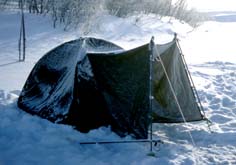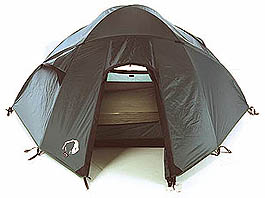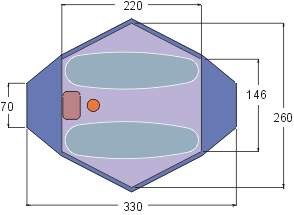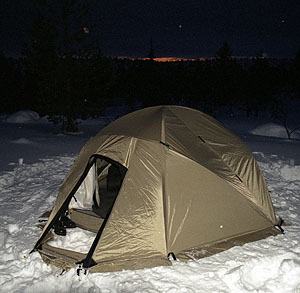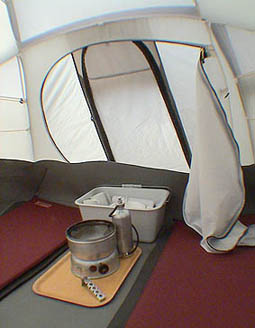Dimensions | Modifications | Meaning of the apse | Colour | Pitching | Furniture and use | Washing | Cooker | Links
Already for years in hiking club
Kavtsi
in Helsinki they have applied for winter camping
a method developed by Kyösti Lamminjoki, in which the tent is heated
by a cooker. Kavtsi´s Kösäkkö-tents are actually Finnish Sopu-tents of
60´s, completed with a waterproof flysheet. They have their own benefits and
weaknesses in comparison with modern tents. Kösäkkö has a ventilation pipe
through both inner and outer tent. The pipe does not seem to be quite necessary,
if there are enough vents in the tent. The commercial tent models of today are
supplied with almost too good ventilation, like Sherpa Dome
shown here. There vents had even to be stitched to close. Sherpa Dome is
quite good alternative to the original Kösäkkö with small fixings.
Sherpa Dome is a classic four-pole geodesic dome tent, which has dual symmetrical entrances and vestibules. It has been in production program of Tatonka already for a long time. The first model came into the market about 1990. It has been produced in different colour versions and it has gone through small modifications, but in general it is an old construction. There are four vents with mesh screens in a new tent, but they can´t be closed. The skirt of outer tent rises about five centimeters above the ground surface, and there are no snowflaps. The roof has only four attachments for roof drying mesh. In tests and comparisons TSD has not done well. In the tent test of a Finnish magazine Erä 4/2002 it, or in fact its model Plus, was actually placed the last. Its worst features were regarded the weigth and inconvenient pitching arising from discontinuous pole sleeves. The pole sleeves are nowadays continuous and the pitching is very easy. The weight is as it is, the geodesic like this is not intended to be carried on back. By its features I personally rated the tent number one, otherwise I wouldn't have bought it. In the German magazin Outdoor Sherpa Dome (model Plus as well) get a minus, because it is not snowproof (schneedicht). Indeed it isn't, that's why I started my stitchwork. With a few small additions I got cheaply an excellent tent to myself. There is luxuriously space for two persons in the tent. Also a third one would easily get in it, but not four full-growns, although some internet site is claiming so. Entrances have beside zippers also rip tape fastening, so the freezing of zippers is not so fatal. The tent is very pretty work, made in Vietnam. The price of Tatonka Sherpa Dome is quite low, but it is not imported to Finland. Its price-quality ratio is excellent. I ordered my tent in autumn 2004 from Pieper in Germany and paid € 306,20 for it. The sum includes Himmeltasche (roof mesh) and sending costs. The prices seem to have risen a little from that, but a little surfing on the net is surely always worth doing. Tatonka Sherpa Dome is quite heavy for a hiking tent – weighing
with summer accessories 4,6 kg and modified to a winter tent 4,8 kg – but in a
pulka it goes along easily, as well as on paddling trips
in summertime in the canoe. As a lodging for paddling trips
Sherpa Dome is especially suitable. It's heat features are excellent and it can
be pitched without any fixings with pegs when needed. The canopy is partly of bare mosquito mesh and the mesh is coarse
enough for the air flow, unlike e.g. in Hilleberg tents, which have too dense
mesh. Because the pole sleeves are fixed to the canopy, it stands independently.
You can place the flysheet so that it is only partially on, to shadow from the
sun. The German mail-order business Globetrotter has taken off Sherpa Dome from the 2005 assortment. (Model Plus is sold still normally.) Dimensions of the tent were years wrong in the catalog of Globe. So I'm not surprised, that the business with that maybe goes poorly. Who would really purchase a tent whose sleeping length is only 200 cm? So was stated on the site of Globe and in the catalog, although the right lenth has always been 220 cm, which is more than average. On the other hand, the plan drawing of Tatonka itself is incorrect. In fact the shape of the tent is a little more practical, than is implied in the plan drawing. In addition, the photos of Tatonka are without the vents on both sides.
Although the Sherpa Dome is a good tent, it is not ready as such for winter camping with heating the tent by a camping cooker. Four big ventilation holes and an air gap below the skirt of the flysheet causes the air blow through the tent even at a weak wind, and the heat doesn't stay in. The snow also gets to whirl in from the vents, although the mesh screens possibly prevent its access so far as to the inner tent. For the winter use the snow flaps are necessary. Their adequate breadth by my experience seems to be about 20 cm. The material could be any fabric, but I came to order from Greendoor (Finnish importer of Tatonka) the same polyurethane-coated polyester, about which the Tatonka flysheet is made. A bit of 1,5 x 1,5 metres cost 19 euros with post costs. It was enough for the snow flaps around the tent and still there was material left for closing the mosquito meshes in entrances. The very upper parts of the entrance flaps are made of mosquito mesh in Sherpa Dome, and it is not possible to close them completely. I made patches of the size of mesh holes and stitched them calmly on the mosquito meshes. So I closed the doors completely. The meshes I left on their places, but I could have taken them off entirely. For the ventilation the upper parts of the doors can still be opened by zippers. Actually, the mosquito meshes are not needed at the doors in winter. Nor in the summer. I have never understood the function of the mosquito meshes in the outer tent. Through the open gap between the flysheet and the ground the insects get freely inside the outer tent and the inner tent has its own mosquito mesh. From the vents on both sides I took off the brace of eaves and instead of it I stretched a sturdy rubber band. So the vents became quite closed, but they can be opened easily if needed, by using a finger-long stick to keep the hole open. The rubber band pulls its tunnel into wrinkles, thus the hole doesn't get cosed very tight. At the wind a little air flow seems to come under the eaves into the tent, but in the first experiments there wasn't much harm of it.
A drying mesh to the tent roof is available as an accessory. Besides it I had to stitch a lot of attachment loops to the roof for drying lines. They were necessary, because the Himmeltasche of Tatonka is miserably small, only about 40 x 50 cm. Hanging from the roof in even 40 degrees heat of the cooker, the wet clothes dry quickly, so there's no need to take along spare equipment. A Kösä-tenter doesn't have to suffer from wet sleeping bags or the felt linings of the boots during the trip, because the equipment are easy to keep dry in the heat of the tent.
There is a Plus-version of the Tatonka Sherpa Dome tent, where a big vestibule has been made by adding a fifth, extra pole. The vestibule is of benefit only when used for cooking and keeping equipment. However, cooking is most comfortable to do inside the tent, a big vestibule is not needed. It's enough if there is room for the snowy boots in the vestibule. There is no other use for the vestibule in the winter tent. A roomy vestibule would only add the useless, but still heat spending volume, and a three-kilowatt cooker can't heat very large space at the frost. Due to the hexagonal floor the lunch and cloth pockets go inside very well, and the rest of the things are left out in the pulkas overnight. You don't need the vestibule as a storage at all. Therefore the "usual" Sherpa Dome is better for winter use than the model Plus.
A dark bluish green seems to be the most popular colour in the tents. Although that isn't quite glaring, it can be distinguished clearly in the woods. Wanted or not, the moss-green of Helsport is in the summer much more natural colour than e.g. dark green of Hilleberg. I'm still wondering about almost total lack of elegant stone grey in the colour assortments of tents.
Dark colouring and the possible aluminium coating of the fabric make the inside of a tent very lightless. So artificial lighting is needed in the green and camouflage Kösäkkös even in the daytime, if the door is closed. The most unconstrained colour for a winter tent would certainly be white, but no such tent has been available, except for natural coloured canvas tents. Certainly a white tent is possible to purchase by having made one or making it yourself. I haven't found a skilled tent maker in Helsinki, regardless of my experiments. The tents of Tatonka are available in sand-colour, which is called cocoon. It is something like khaki, but in some light more greenish, almost light olive. It is an attractive, natural colour and fair enough to let light through it. It is very suitable to use in summer, too. In this site the cocoon of Sherpa Dome seems to be quite different in different photos, although it's the same tent in all of them.
Noisy colours are readily explained with the security reasons. The use of a red tent is easy to understand, if you really don't own any other tent than the one purchased for Greenland crossing. Surprising, how many poor crossers there seem to be. Or maybe they are just planning their trip and hoping, that others would notice these intentions, too.
The place of the tent is cross-stamped with the skis and the snow is let to freeze to supporting. It takes a few minutes depending on the circumstances. While waiting for it the pitching of the tent can be started nearby. There's no need to dig the tent deep in the snow, it would be of no advantage. The stable geodesic doesn't need a pit for the shelter from the wind. I personally don't even take a snow shovel with me to a mild winter trip to the fells of Lapland. The poles are first threaded through their sleeves. It's easy, because the pole sleeves are continuous and the poles slide well in them. Then the ends of the poles are slipped in the corresponding eyelets of the straps. During pitching you can stand in one place and rotate the tent. This is necessary, too, if the snow is deep and you have to stay on the skis all the time. When the inner tent is pitched, the outer tent is set over it. It works best to the following wind, and at that moment the pitching mate is most of service, but it can be made alone, too. The tent is then moved up to its stamped place and fixed trough the strap loops of the entrance to the snow with long snow pegs, or with the skis and the sticks. The wooden snow pegs are handy and light and they can be self-made. A little of snow can be kicked on the snowflaps if needed, especially to the windy side. The furniture of the tent and its use "Wall-to-wall carpets" or 3 mm closed-cell foam (e.g. Termolon, width 1,5 m) are first set in, rising 20–30 cm up to the walls. This insulation reduces the moisture of the sleeping bag caused by the condensated water when touching the wall. It also reduces the feel of a draft in the tent. Then the mattresses are placed on the carpet. The box for cooking utensils is placed by the gable wall between the mattresses, and the cooker in front of it, on its plywood tray. The rest of the equipment is thrown in, the pulkas are closed and everything is ready to camp in. You get in through the entrance of the lee side, and its zipper is left ajar about five centimeters. The wind side door is closed completely. There's no need to worry about replacement air, there always remain enough holes under the skirt of the tent anyway. A little pressure is pumped into the tank of the cooker, about 5 cl spirit is portioned with a syringe in the preheating cup of the burner and it is fired. When the spirit has burned out, the regular burner is fired and in a little while you can start to take off the outerwear, even if there were hard frost outside. Moistened equipment are hung in the roof mesh and the lines for drying. The sleeping bags are spred to warm up. Cooking can start, and it is easy to do sitting the feet inside the sleeping bag. For the night the cooker is naturally turned off and the pressure is let out of the tank. Waking up in a fierce frost morning is very different in the Kösäkkö from what it is with the fakirs, who don't want to heat their tent. The morning activities in our tent typically go like this: First one opens the sleeping bag a little, so that the hands can be pushed out. The head end of the sleeping bags, one's own and the trekmate's, are scratched clean from the frost with a small brush. Then a little pressure is pumped in the cooker. A little spirit is sucked from a small bottle into the measuring syringe and it is squirted into the burner. It is fired, and one can draw back into the warmth of the bag for a while. When the preheating flame has gone out, the hands are put out of the bag to fire the regular flame and turn it to full. Again one can draw back to doze into the warm sleeping bag. When the frost is melting and water drops begin to fall down from the roof, the Kösä-tenter opens the sleeping bag and crawls out in the comfortable warmth. One can only imagine, how the fakir feels waking up in a frost-cold tent, from which he has to go out in thick clothing to make the breakfast! Because there are two entrances in
the tent,
snow can be scooped handy to melt in the kettle from the head-side apse , while the ski boots
are kept in the foot apse. Through the same head-side entrance
within reach the dishwater can be poured into the snow
inside the apse as well, without crawling with the kettles as far as the
entry or even open the door. This is a great benefit in the wind and snowstorm.
One only has to remember from which side, the left or the right, the clean
snow is taken and which the dishwater is poured to.
Valuable water melted from snow with great effort is never wasted: First hot water is poured into the mug, where also the spoon is washed. Then the same water is poured on the plate, and after washing it into the kettle. Washing agent is not used, but a dishbrush is a must. The whole set can be washed with half a mug of water! In the end the utensils are wiped clean with a paper towel. A cooker used inside the tent has its own requirements, of which the security is not the least. Therefore petrol cookers don't come into question. When playing with fuel there is always a danger, that it leaks into the tent. Petrol evaporates and makes a dangerous, explosive or flashable air mixture even in the frost degrees, while paraffin evaporates at just about 40 plus-degrees (Celsius). Therefore Kösä tenters use exclusively paraffin as fuel. It is used about 0,7 litres per a tenthold per day or five litres per week, if all water is melted from snow. Gas and spirit are ineffective and therefore not suitable for heating a winter tent. The design of the cooker is important, too. When the equipment is used in the tent every morning and evening, it shouldn't make too disturbing noise. Many popular cookers are too noisy to use continuously. This kind of cookers are Primus and MSR, except perhaps WhisperLite. The best cookers for winter use were KAP-Arctic or Optimus 11 Explorer using hat burners, but unfortunately neither of them is no longer in production. The old fellow Optimus 111C Hiker may be the best availble winter burner so far. Some stoves in a table.
|
|||||||||||||||||||||||||||||||||||||||||||||||||||||||||||||||||||||||||||||||||

